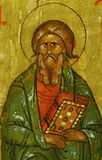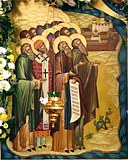

| Previous day | Next day |
| Old Style
August 9
|
Thursday |
New Style
August 22
|
|
10th Week after Pentecost.
Tone 8.
Успенский пост. |
Monastic rule: cooked food, no oil.
|
![]() Holy Apostle Matthias (ca. 63).
Holy Apostle Matthias (ca. 63). ![]() Synaxis of the Saints of Solovki.
Synaxis of the Saints of Solovki.
St. Psoes of Egypt (4th c.). Martyrs Julian, Marcian, John, James, Alexis, Demetrius, Photius (Phocas), Peter, Leontius, Mary the patrician, and others, of Constantinople (730). Martyr Anthony of Alexandria. St. Macarius, founder of Oredezh Monastery (Novgorod) (1532). St. Philaret (Gumilevsky), archbishop of Chernigov (1866).
Icon of the Savior “Not-Made-by- Hands” of Camuliana in Cappadocia (ca. 303).
Thoughts for Each Day of the Year
According to the Daily Church Readings from the Word of God
By St. Theophan the Recluse

Thursday. [II Cor. 1:1-7; Matt. 21:43-46]
The chief priests and Pharisees perceived that the Lord was telling parables on their account, that He was opening their eyes so that they would see the truth. But what did they do with this? They thought about how to kill the Lord. If their common sense had not been distorted by their prejudice, then even if they could not believe, as the obviousness of the instruction required, they should at least have thought over carefully whether what the Savior was saying is true. Their prejudice pushed them onto a crooked path, and they then proved to be God-killers. It always has been this way, and it is this way now. The Germans, and our people who have followed after them and become Germanized in their thought, immediately cry out whenever they come across a miracle in the Gospels, “Not true, not true; this didn’t happen and couldn’t happen, this needs to be crossed out.” Is not this the same as killing? Look through all the books of these clever men; in none of them will you find any indication as to why they think this way. Not one of them can say anything against what the Gospel truth proves, and not one cares to comprehend the arguments which soberminded people use to convict their falseness; they only continue insisting that [what is written] could not be, and that is why they do not believe the Gospels. And you cannot do anything with them—they are ready to go against God Himself.


